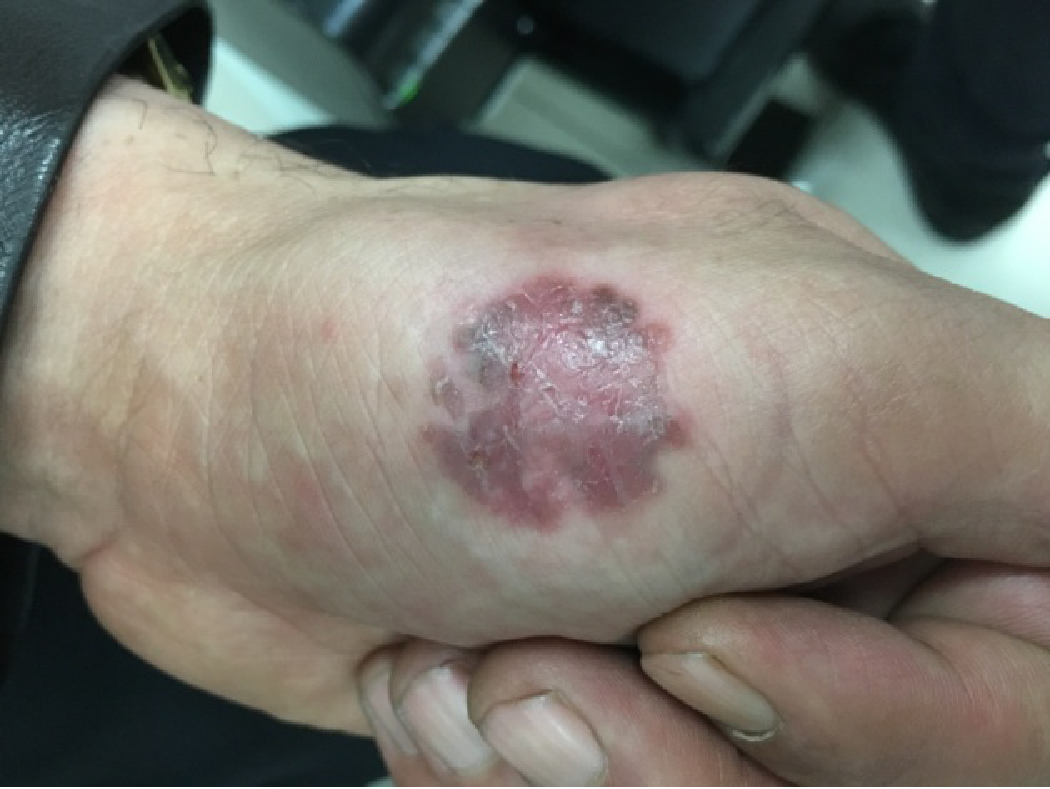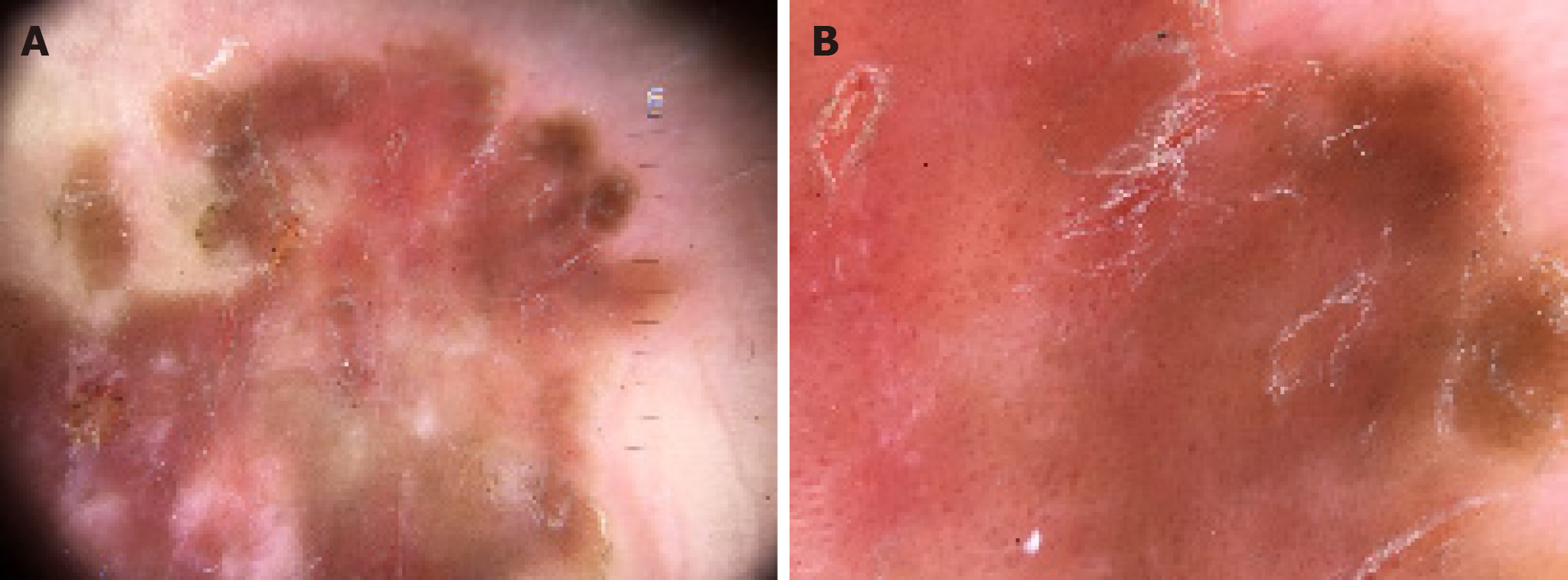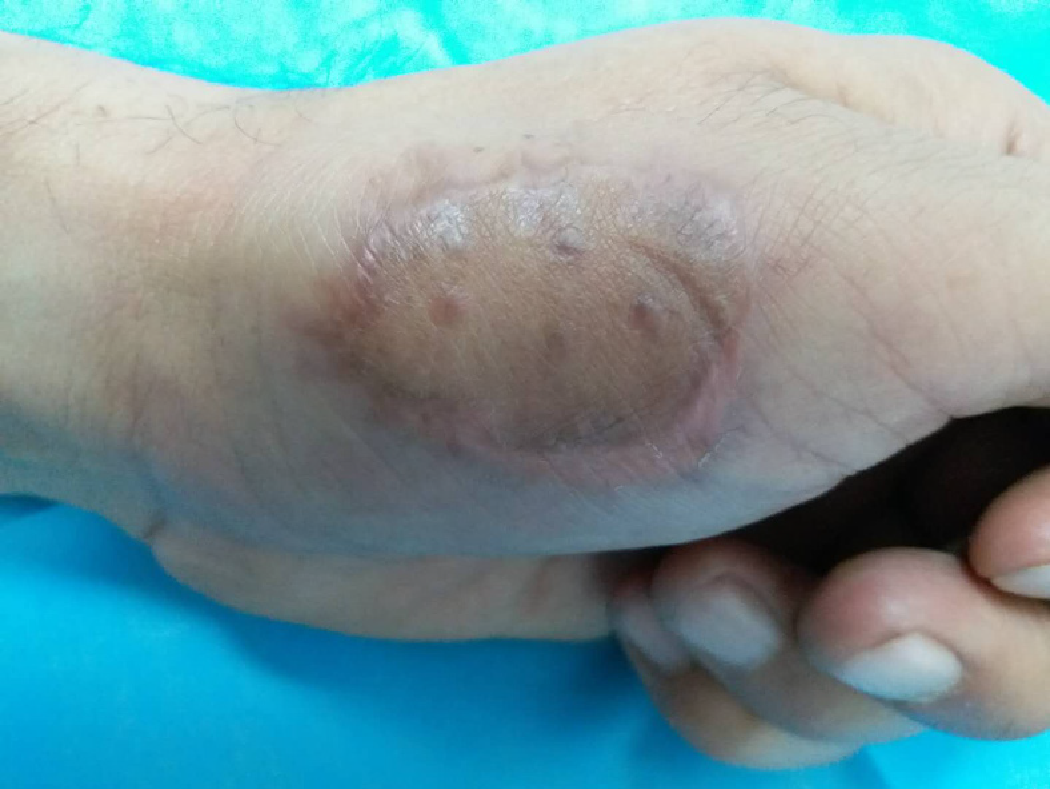Published online Sep 26, 2019. doi: 10.12998/wjcc.v7.i18.2910
Peer-review started: May 23, 2019
First decision: August 1, 2019
Revised: August 14, 2019
Accepted: August 27, 2019
Article in press: August 26, 2019
Published online: September 26, 2019
Processing time: 131 Days and 18.5 Hours
Bowen’s disease (BD) is a persistent, progressive intraepidermal carcinoma. BD usually occurs in areas exposed to sunlight. Involvement of the dorsum of the hand is not rare, but that of the palmar aspect is very unusual. Only a few cases have been reported in the literature.
Here, we report the case of a 48-year-old male patient who presented with a history of persistent local erythema lasting for 2 years on the thenar eminence of the left palm. Initially diagnosed as hand eczema, the condition did not improve with intermittent treatment with anti-allergy medications or topical glucocorticoid ointments, among other approaches. Then, the area of erythema gradually enlarged and was accompanied by mild itching. For a definite diagnosis and treatment, the patient came to our hospital. Dermoscopic examination revealed BD, and histopathological examination confirmed the diagnosis. We performed partial resection of the skin lesion followed by photodynamic therapy. No recurrence was observed at the 6-mo follow-up.
For all atypical palmar lesions, early dermoscopy and/or skin biopsy are needed to avoid missed diagnosis or misdiagnosis.
Core tip: The palm is a rare site for Bowen’s disease (BD). Local erythema and scaly skin are the first symptoms, which are easily misdiagnosed. We report a case of BD on the left palm that may have been induced by physical stimulation. Dermoscopy had a specific diagnostic performance, and skin biopsy further confirmed the diagnosis. In this case, there was no local recurrence after surgical resection and photodynamic therapy (PDT). Surgery combined with PDT can be used as an effective strategy for treating BD. Dermoscopy can be used as a routine examination for the diagnosis of chronic erythemato-squamous diseases.
- Citation: Yu SR, Zhang JZ, Pu XM, Kang XJ. Bowen’s disease on the palm: A case report. World J Clin Cases 2019; 7(18): 2910-2915
- URL: https://www.wjgnet.com/2307-8960/full/v7/i18/2910.htm
- DOI: https://dx.doi.org/10.12998/wjcc.v7.i18.2910
Bowen’s disease (BD), also known as squamous cell carcinoma in situ, is characterized by isolated, slowly enlarged, erythematic, squamous papules or plaques. The borders are often sharply marginalized but may be irregular. Its aetiology and pathogenesis are still unclear but are mainly related to long-term exposure to inorganic arsenic, viral infection, external stimuli, excessive ultraviolet radiation, and genetic factors. BD most commonly occurs on the head and neck, trunk, lower limbs, and mucous membranes. Kossard et al[1] analysed 1001 cases of BD in 1992 and found no cases on the palm. Until now, only a few cases of BD on the palm have been reported. In most of these cases, the patient had risk factors for BD, such as arsenic exposure or human papilloma virus (HPV) infection. Here, we present a case of BD clinically presenting as erythema on the left palm.
A 48-year-old man of Uygur ethnicity was admitted to the People’s Hospital of Xinjiang Uygur Autonomous Region with a history of persistent local erythema for 2 years on the left palm.
The patient did not have a specific history of past illness.
His family history was unremarkable.
A dark red erythematic area 2.1 cm × 3.0 cm in size and irregular in shape was observed on the thenar eminence of the left palm, with desquamation on the surface, no ulceration or exudation, and a clear lesion boundary (Figure 1).
We investigated 23 HPV genotypes (6, 11, 16, 18, 31, 33, 35, 39, 42, 43, 44, 45, 51, 52, 53, 56, 58, 59, 66, 68, 73, 81, and 82) by PCR, and no HPV genotypes were detected from the lesion. Fungi and non-tuberculous mycobacteria were also not identified by tissue culture. Tissue specimens were obtained by biopsy.
Dermoscopy revealed a clear, scaly, reddish-brown background with glomerular vessels and a scaly surface, which are specific features of BD (Figure 2). Skin biopsy of the erythema on the left palm showed hyperkeratosis and parakeratosis, atypical keratinocytes throughout the epidermis, most mitotic phases, disordered cell arrangement, and dyskeratotic cells; additionally, some keratinocytes were vacuolated. A moderate amount of inflammatory infiltrate was present in the upper dermis, which is consistent with BD (Figure 3).
According to the pathological examination, the final diagnosis was BD.
The lesion was surgically removed. The safe margin for resection of the lesion is 5 mm and the depth are the full thickness of the skin. After the suture removal, the skin lesion and around 0.5 cm was incubated with a 20% 5-amino-levulinic acid oil-in-water emulsion and photosensitized for 4 h under blocking. Using Omnilux 630 nm as the light source, the delivery dose was 63 J/cm2. Three photodynamic therapies (PDT) were given at intervals of 2 wk to prevent recurrence. No adverse events occurred.
The symptoms of pruritus disappeared in the skin lesion of the patient after surgery, and no recurrence was observed at the 6-mo follow-up (Figure 4). We will continue to follow this patient in order to see if there is recurrence in the later period.
BD usually affects the elderly and mainly occurs in areas exposed to sunlight. However, it can also occur in areas that are not exposed to the sun, such as the genitalia. BD rarely occurs on the palm or sole. There have been few reports on the occurrence of BD on the palm worldwide.
In 1969, Achten et al[2] reported the first case of BD on the palm, which was treated with 5-fluoro-uracil ointment. So far, nearly 20 similar cases have been reported worldwide. Some reports have been published for a long time, the full text cannot be obtained, and the diagnosis and treatment methods cannot be clearly defined. Therefore, we reviewed the reports over the last 20 years. There have only been seven reports of BD on the palm[3-9] (Table 1), with most cases occurring in middle-aged and elderly patients. The proportion of males and females was similar. The course of the disease was 2-15 years. The lesion size was mostly greater than 1 cm. The aetiology was mainly related to HPV infection and contact with arsenic. The patient described in this case had no history of arsenic exposure. PCR technology was used to detect HPV, and no evidence of the virus was found. Fungi and non-tuberculous mycobacteria were not identified by tissue culture. The patient is a truck driver, and the lesion was on the thenar eminence of the left palm. Long periods of friction against the steering wheel might be related to the occurrence of BD in this case and may be an important risk factor for BD.
| Authors | Year | Age | Sex | Symptom duration | Size (cm) | Treatment | Recurren-ce | Follow-up | Possible incentives |
| Cöl et al[3] | 1999 | 35 | M | 5 yr | N/R | Cysplatin and 5-fluorouracil, radiotherapy | Yes | 6 mo | Arsenic |
| Cavicchini et al[4] | 2010 | 59 | M | 5 yr | 1.4 × 1.2 | N/R | N/R | N/R | HPV42 |
| Harnalikar et al[5] | 2011 | 42 | F | 15 yr | 5.0 × 6.0 | 5-fluorouracil | N/R | N/R | Arsenic |
| Murao et al[6] | 2013 | 76 | F | 2 yr | 1.6 × 1.0 | Excision | No | 1 yr | HPV52 |
| Kitamura et al[7] | 2014 | 49 | F | 4 yr | 0.8 × 0.8 | N/R | N/R | N/R | N/R |
| Nakayama et al[8] | 2016 | 85 | F | 2 yr | 3.5 × 2.8 | Excision | N/R | N/R | HPV16 |
| Wilmer et al[9] | 2013 | 48 | M | 15 yr | 1.5 × 1.0 | Excision | No | 1 yr | N/R |
In three of the seven reported cases, the patients underwent surgical resection and did not develop recurrence after surgery[6,8,9]. One patient was treated with 5-fluorouracil[5]. One patient underwent combined treatment with cisplatin, 5-fluorouracil, and radiotherapy because of lymph node metastasis[3]. By the 6-mo follow-up, the patient had relapsed and was treated surgically. The most effective treatment for BD is surgical resection; other methods, such as 5-fluorouracil, cryotherapy, and PDT, can also be applied. If there is metastasis, comprehensive treatment is needed. Moreover, good therapeutic results have also been achieved with PDT for BD at some unique sites, such as subungual sites[10]. In this study, surgical treatment combined with postoperative PDT further helped prevent recurrence. This method can be used in patients with a high expected postoperative recurrence rate.
BD on the palm is rare and can mimic psoriasis, eczema, lichen planus, or contact dermatitis. Infectious aetiologies, such as fungal infections and skin tuberculosis, also need to be ruled out. For the identification of these diseases, dermoscopic examination is feasible. Studies have shown that the presence of glomerular vessels is a sensitive standard for BD and can guide clinicians to correctly diagnose atypical lesions[4,11], which is consistent with our dermoscopic findings.
Dermoscopy is convenient and fast and can be used as a routine examination method for detecting skin diseases. In cases of long-term, unhealed erythema, even if there are no obvious symptoms, attention should be paid, and early dermoscopy and/or skin biopsy are needed to avoid missed diagnosis or misdiagnosis.
Author contributions: Yu SR and Zhang JZ contributed equally to this work. Yu SR designed the study; Zhang JZ and Pu XM contributed to surgical treatment and follow-up data collection, analyzed the data, and wrote the paper; Kang XJ revised the manuscript; all authors read and approved the final manuscript.
Manuscript source: Unsolicited manuscript
Specialty type: Medicine, Research and Experimental
Country of origin: China
Peer-review report classification
Grade A (Excellent): 0
Grade B (Very good): 0
Grade C (Good): C, C, C, C
Grade D (Fair): D
Grade E (Poor): E
P-Reviewer: Kimyai-Asadi A, Firooz A, Manolache L, Husein-ElAhmed H, Cuevas-Covarrubias SA, Kaliyadan F S-Editor: Dou Y L-Editor: Wang TQ E-Editor: Zhou BX
| 1. | Kossard S, Rosen R. Cutaneous Bowen's disease. An analysis of 1001 cases according to age, sex, and site. J Am Acad Dermatol. 1992;27:406-410. [RCA] [PubMed] [DOI] [Full Text] [Cited by in Crossref: 105] [Cited by in RCA: 91] [Article Influence: 2.8] [Reference Citation Analysis (0)] |
| 2. | Achten G, Van Oost A. [Bowen's disease of the palm of the hand. Treatment by 5-fluoro-uracil ointment]. Bull Soc Fr Dermatol Syphiligr. 1969;76:322-323. [PubMed] |
| 3. | Cöl M, Cöl C, Soran A, Sayli BS, Oztürk S. Arsenic-related Bowen's disease, palmar keratosis, and skin cancer. Environ Health Perspect. 1999;107:687-689. [RCA] [PubMed] [DOI] [Full Text] [Cited by in Crossref: 5] [Cited by in RCA: 13] [Article Influence: 0.5] [Reference Citation Analysis (0)] |
| 4. | Cavicchini S, Tourlaki A, Ghislanzoni M, Alberizzi P, Alessi E. Pigmented Bowen disease of the palm: an atypical case diagnosed by dermoscopy. J Am Acad Dermatol. 2010;62:356-357. [RCA] [PubMed] [DOI] [Full Text] [Cited by in Crossref: 7] [Cited by in RCA: 7] [Article Influence: 0.5] [Reference Citation Analysis (0)] |
| 5. | Harnalikar M, Dongre A, Khopkar U. Bowen'S disease on palm: a rare presentation. Indian J Dermatol. 2011;56:353-354. [RCA] [PubMed] [DOI] [Full Text] [Cited by in Crossref: 4] [Cited by in RCA: 5] [Article Influence: 0.4] [Reference Citation Analysis (0)] |
| 6. | Murao K, Tetsutani M, Ishigami T, Kubo Y, Arase S. Bowen disease of the palm associated with human papillomavirus 52. Clin Exp Dermatol. 2013;38:489-491. [RCA] [PubMed] [DOI] [Full Text] [Cited by in Crossref: 7] [Cited by in RCA: 7] [Article Influence: 0.6] [Reference Citation Analysis (0)] |
| 7. | Kitamura S, Iwata H, Imafuku K, Hata H, Natsuga K, Aoyagi S, Shimizu H. Bowen's disease on the palm presents refractory skin erosion without erythematous plaque. J Dermatol. 2015;42:225-226. [RCA] [PubMed] [DOI] [Full Text] [Cited by in Crossref: 2] [Cited by in RCA: 2] [Article Influence: 0.2] [Reference Citation Analysis (0)] |
| 8. | Nakayama C, Hata H, Imafuku K, Toyonaga E, Shimizu H. HPV16-related pigmented Bowen's disease on the palm. J Eur Acad Dermatol Venereol. 2016;30:138-140. [RCA] [PubMed] [DOI] [Full Text] [Cited by in Crossref: 2] [Cited by in RCA: 2] [Article Influence: 0.2] [Reference Citation Analysis (0)] |
| 9. | Wilmer EM, Lee KC, Higgins W 2nd, Cruz AP. Hyperpigmented palmar plaque: an unexpected diagnosis of Bowen disease. Dermatol Online J. 2013;19:18573. [PubMed] |
| 10. | Photiou L, Sinclair R. Subungual Bowen disease. Complete remission 14 years post-photodynamic therapy (PDT). Australas J Dermatol. 2019;60:74-75. [RCA] [PubMed] [DOI] [Full Text] [Cited by in Crossref: 2] [Cited by in RCA: 2] [Article Influence: 0.3] [Reference Citation Analysis (0)] |
| 11. | Zalaudek I, Argenziano G, Leinweber B, Citarella L, Hofmann-Wellenhof R, Malvehy J, Puig S, Pizzichetta MA, Thomas L, Soyer HP, Kerl H. Dermoscopy of Bowen's disease. Br J Dermatol. 2004;150:1112-1116. [RCA] [PubMed] [DOI] [Full Text] [Cited by in Crossref: 149] [Cited by in RCA: 144] [Article Influence: 6.9] [Reference Citation Analysis (0)] |












